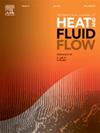Investigate the impact of different fin configurations arranged in-line on the double-pipe heat exchanger’s hydrothermal response
IF 2.6
3区 工程技术
Q2 ENGINEERING, MECHANICAL
International Journal of Heat and Fluid Flow
Pub Date : 2025-04-05
DOI:10.1016/j.ijheatfluidflow.2025.109834
引用次数: 0
Abstract
The target of the present study is to investigate the effect of fin configuration and split in-line arrangement on the response of a DPHX’s hydrothermal system. The effect of both fin configurations, namely, longitudinal and wavy, was considered in this study. The ANSYS Fluent 2022 R1 software is used to create the 3D models and get the numerical results. To estimate the hydrothermal response of the heat exchanger, several parameters, such as the friction factor, thermal resistance, and Nu number are analyzed. A comparison between the numerical results and experimental findings for the traditional model is conducted to verify the numerical results, and the comparison showed good agreement between them. The results have shown that the hydrothermal response of a double pipe heat exchanger is affected by the fin configuration. Among all the models under investigation, Model D, characterized by eight fins arranged in a wavy pattern, emerged as the most optimal. It exhibited a Nu number that was 46.39 percent higher compared to the conventional model. Furthermore, it should be noted that models B and D exhibit the most superior overall performance factor values. Furthermore, the results indicated that models B and D exhibit an overall performance factor value of 1.330 and 1.313, respectively.
求助全文
约1分钟内获得全文
求助全文
来源期刊

International Journal of Heat and Fluid Flow
工程技术-工程:机械
CiteScore
5.00
自引率
7.70%
发文量
131
审稿时长
33 days
期刊介绍:
The International Journal of Heat and Fluid Flow welcomes high-quality original contributions on experimental, computational, and physical aspects of convective heat transfer and fluid dynamics relevant to engineering or the environment, including multiphase and microscale flows.
Papers reporting the application of these disciplines to design and development, with emphasis on new technological fields, are also welcomed. Some of these new fields include microscale electronic and mechanical systems; medical and biological systems; and thermal and flow control in both the internal and external environment.
 求助内容:
求助内容: 应助结果提醒方式:
应助结果提醒方式:


